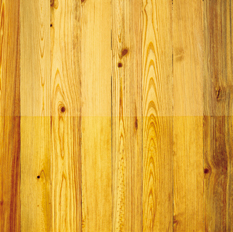Staining Wood Floor After Sanding
Staining your wood floor after sanding changes wood’s natural pigment; stain, by itself, does nothing to seal the floor against moisture and wear.
Floor staining is not a requirement, of course, because many homeowners prefer their floors clear-coated after sanding. But many types of flooring species such as lighter grained soft woods like pine (see image) can benefit from stain.
Oil-Based vs. Water-Based Floor Stains

Typically, floor stains are either water-based, oil-based. Most homeowners who use water-based floor stains use them because these stains do not smell as bad as oil based stains. One minor downfall of these water-based stains that they do absorb into the grain of the wood and make the grain stand out more. With this prominent floor grain, you need to make an additional pass with the sander to bring it down, but only with the finest grit paper on the sander.
Oil based stains smell horrible and take far longer to dry than the water-based stains, but are considered to be highly durable stains.
Fast-Drying Floor Stains
There is a third category of stains, though: fast-drying stains. Fast drying stains are just as they sound: partially oil-based stains with some drying additives to help the stain set rather quickly.
Tip: How to Get Floor Stain Shade Right
When your floor was installed, you probably received a lot of waste materials. Waste materials are scraps of floorboards that were cut off of longer pieces, but deemed unusable. These waste pieces of floor boards have great value because you can use them as test pieces for your stain.